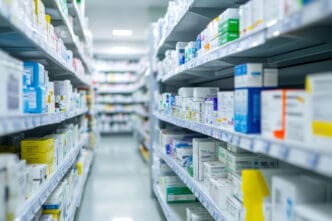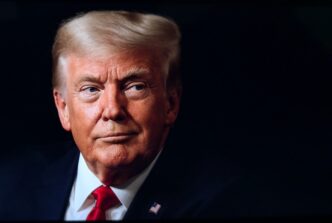KEY POINTS
- President Trump has promised to cut prescription drug prices by as much as 1,500%, a mathematically impossible but politically powerful claim, and is publicly pressuring the pharmaceutical industry to lower its prices.
- The core of Trump’s strategy is the “Most Favored Nation” policy, which would require drugmakers to offer the U.S. the same prices they offer in other developed countries, a plan he is now pushing for through public pressure and executive orders.
- The administration’s push to lower drug prices is complicated by its simultaneous plan to impose tariffs on the pharmaceutical industry, a move that experts warn could have the opposite effect and actually raise drug costs.
WASHINGTON – President Donald Trump has made his most audacious and mathematically questionable claim yet in his long-running campaign to lower the cost of prescription drugs, promising on Sunday to cut prices by as much as 1,500% in the coming months.
“You know, we’ve cut drug prices by 1,200, 1,300 and 1,400, 1,500%,” he told reporters. “I don’t mean 50%. I mean 14- 1,500%.”
The president’s remarks mark a dramatic escalation in his rhetoric as he publicly ratchets up the pressure on the pharmaceutical industry to voluntarily lower its prices. However, the claim of a 1,500% price cut, which is mathematically impossible, has been met with deep skepticism from policy experts. While the administration has unveiled a number of moves aimed at cutting drug prices, it has yet to move the needle on reducing costs, and its most powerful tool—a controversial “Most Favored Nation” policy—faces significant legal and practical hurdles.
The episode highlights the central tension in the president’s approach: a powerful political message that resonates with voters who are desperate for relief from high drug costs, pitted against the complex reality of a healthcare system where the administration has limited unilateral power to force the sweeping changes it has promised.
The “Most Favored Nation” Gambit
The core of the president’s strategy is a policy that would require drugmakers to offer the same price in the United States as they do in Europe and other peer countries, the so-called “Most Favored Nation” price. It is a well-documented fact that the U.S. paid nearly three times as much for medications as comparable developed countries in 2022, and the administration sees this policy as the primary lever to correct that imbalance.
This is not a new idea for the president. He tried to force this policy on the industry near the end of his first term, finalizing a rule for a model program in which Medicare would pay the “Most Favored Nation” price for 50 drugs administered in doctors’ offices. That initiative, however, was quickly blocked in federal court on procedural grounds and was later rescinded by the Biden administration.
Now, in his second term, Trump is reviving the strategy, but with a twist. Instead of immediately imposing a rule that would likely face another protracted legal battle, he is attempting to use the full weight of the presidency to pressure drug manufacturers into voluntarily offering U.S. patients the lowest price paid for a drug in a peer country—or face unspecified repercussions.
“Big Pharma will either abide by this principle voluntarily or we will use the power of the federal government to ensure that we are paying the same price as other countries to accelerate these price restrictions and reductions,” the president said in May when signing an executive order on the policy.
The potential ramifications for non-compliance are significant. The administration has hinted it could direct the Department of Health and Human Services to craft a new rule implementing the policy, allow for greater importation of drugs from other countries, or even have the Food and Drug Administration review or revoke approvals for certain drugs.
A Public Pressure Campaign
After months of private discussions between HHS and the drugmakers failed to yield the results he wanted, the president has taken his pressure campaign public. Late last month, he sent letters to the CEOs of 17 major pharmaceutical companies, which were then posted on Truth Social and read aloud at a White House briefing.
In the letters, Trump made his demands explicit. He called for manufacturers to extend “Most Favored Nation” pricing to all drugs provided to Medicaid enrollees and demanded that all government and commercial insurers pay these lower prices for all new drugs.
“Moving forward, the only thing I will accept from drug manufacturers is a commitment that provides American families immediate relief from the vastly inflated drug prices and an end to the free ride of American innovation by European and other developed nations,” he wrote, giving the companies 60 days to comply.
The Limits of Presidential Power
Despite the president’s powerful rhetoric, the reality is that the administration has limited authority to unilaterally force such sweeping changes on the industry.
“The administration, by itself, has relatively limited power to affect drug prices across the US market,” Benedic Ippolito, a senior fellow in economic policy studies at the right-leaning American Enterprise Institute, told reporters. “Congress has tons of power, but the administration, if they’re acting by themselves, there’s just only so much they can do.”
Still, the political pressure is immense and should not be dismissed by the industry. “President Trump already has a track record of disruptive policymaking and a willingness to push the limits,” said Milena Sullivan, a policy director at the consulting firm Avalere Health. “The rhetoric has only been intensifying. Even if the math doesn’t make sense, the political message is serious.”
A Contradictory Policy: The Threat of Tariffs
Complicating the administration’s push for lower prices is its simultaneous pursuit of another key policy goal: tariffs. The president is also pushing a plan to impose steep tariffs on the pharmaceutical industry, a move that experts warn could have the opposite effect, actually raising drug prices and worsening shortages of generic medicines.
The president has already agreed to the framework of a deal with the European Union that would levy a 15% tariff on most drug imports. The administration has also launched a national security investigation into pharmaceutical imports that is expected to lead to even more tariffs on the sector, with the president floating rates as high as 250%.
While the tariffs are designed to spur more domestic drug manufacturing—and have already prompted a wave of billions of dollars in new U.S. investment announcements from major pharmaceutical companies—they are unlikely to provide Americans with a break on their drug costs. The prices consumers pay are largely governed by the nation’s complex health system, which includes a web of manufacturers, insurers, and powerful pharmacy benefit managers (PBMs).
The administration is also pursuing other, more technical initiatives to lower costs, including supporting PBM reform and looking at ways to reduce Medicare reimbursements to certain hospitals. These more meaningful policies, however, will take time to implement and will likely require the cooperation of a deeply divided Congress.
For now, the president is relying on his bully pulpit. His mathematically impossible promise of a 1,500% price cut is not a detailed policy proposal but a powerful political statement, a clear signal to both voters and the pharmaceutical industry that he is willing to engage in an all-out war to bring down the cost of medicine.








